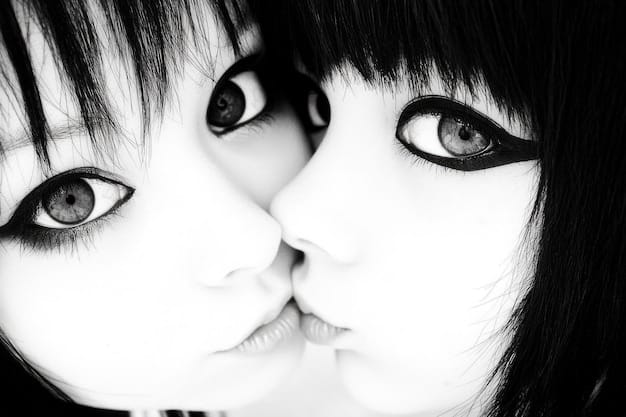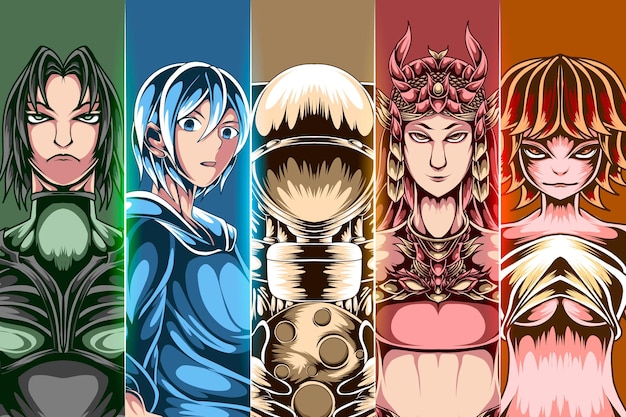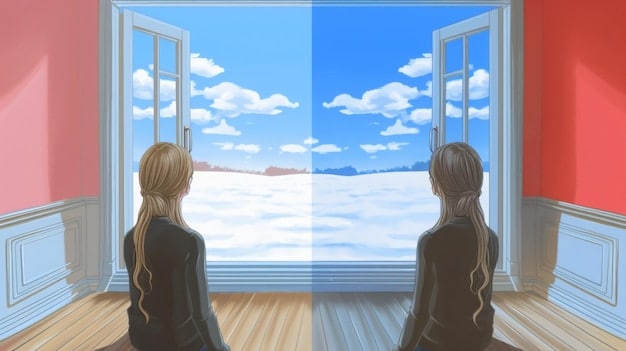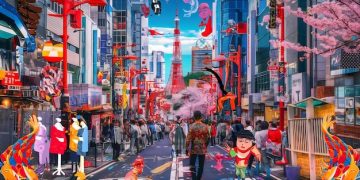Shonen Manga Adaptations: When Does the Anime Outshine the Manga?

Shonen manga adaptations sometimes surpass the original manga through enhanced animation, voice acting, and musical scores, creating a more immersive and emotionally resonant experience for viewers.
When it comes to shonen manga adaptations: When does the anime outshine the manga? This is a question many fans debate. Are the vibrant visuals and dynamic soundtracks enough to elevate the anime beyond its printed source?
Exploring the Essence of Shonen Manga and Anime
Shonen manga and anime represent a cornerstone of Japanese pop culture, captivating audiences worldwide. Both mediums tell stories aimed primarily at a young male audience, typically filled with action, adventure, and themes of friendship and perseverance.
However, they achieve this in distinct ways. Manga relies on static panels, dialogue, and the reader’s imagination to convey a narrative. Anime, on the other hand, brings movement, sound, and color to the story, offering a different sensory experience.

Key Differences Between Manga and Anime
Understanding the core differences between manga and anime is crucial in assessing when an anime adaptation might surpass its source material. These differences extend beyond mere presentation.
- Visual Storytelling: Manga utilizes panels and layouts, relying on the artist’s skill to convey action and emotion. Anime employs animation techniques, voice acting, and music to bring scenes to life dynamically.
- Pacing and Detail: Manga often allows for more detailed exposition and character development due to its less constrained format. Anime adaptations sometimes condense storylines or alter details to fit broadcast schedules.
- Sensory Experience: Manga presents a tactile reading experience, engaging the reader through its artwork and narrative. Anime immerses the viewer through visual animation, auditory cues from soundtracks, and voice acting.
Ultimately, both manga and anime have unique strengths. The key lies in how effectively an adaptation leverages the strengths of anime to enhance or complement the original manga’s narrative.
Animation Quality and Visual Enhancement
One of the most significant factors in determining whether an anime adaptation outshines its manga is the quality of its animation. A well-animated series can elevate the source material, while poor animation can detract from even the best stories.
Advancements in animation technology have enabled studios to create visually stunning anime with fluid motion, detailed character designs, and breathtaking backgrounds.
The Impact of Studio and Director
The studio responsible for animating a manga adaptation plays a crucial role in its success. Studios like Ufotable (Demon Slayer) and Bones (My Hero Academia) are renowned for their high-quality animation and attention to detail.
Similarly, the director’s vision and leadership can significantly influence the adaptation’s overall aesthetic and storytelling approach. A skilled director understands how to translate the manga’s essence into a visual medium, enhancing its appeal.
- Dynamic Action Sequences: Anime can bring manga action scenes to life with fluid animation, impactful sound effects, and creative camera angles.
- Expressive Character Designs: Animators can enhance character expressions and emotions, making them more relatable and engaging for viewers.
- Vibrant Color Palettes: Color adds depth and atmosphere to the story, enhancing the visual experience and creating a stronger emotional connection.
The visual enhancements achieved through animation can significantly contribute to an anime adaptation surpassing its manga counterpart, providing a richer and more immersive experience for the audience.
Sound Design and Musical Score
The auditory elements of an anime, including sound design and musical score, play a vital role in shaping the viewer’s emotional experience. These elements can add depth, tension, and excitement to scenes, enhancing the overall impact of the story.
A well-crafted soundtrack can amplify the emotional resonance of key moments, while impactful sound effects can make action sequences more visceral and engaging.
Voice Acting and Character Portrayal
Voice actors play a critical role in bringing anime characters to life. Their performances can enhance character personalities, emotions, and relationships, making them more believable and relatable.
A talented voice cast can elevate an anime adaptation, breathing new life into beloved characters and adding depth to their interactions.

- Emphasizing Emotional Moments: Music can underscore pivotal scenes, amplifying emotional impact and creating a stronger connection with the characters.
- Building Tension and Suspense: Sound effects and musical cues can heighten tension during suspenseful moments, keeping viewers on the edge of their seats.
- Enhancing Action Sequences: Impactful sound design can make action scenes more thrilling, immersing viewers in the intensity of the battle.
The skillful integration of sound design and musical score can significantly enhance an anime adaptation, creating a more immersive and emotionally resonant experience than the original manga.
Pacing and Storytelling Choices
Anime adaptations often make deliberate choices regarding pacing and storytelling, which can impact how the narrative is received. While manga allows for detailed exposition and character development, anime adaptations sometimes condense storylines or alter details to fit broadcast schedules.
These choices can be controversial, as some fans may prefer a faithful adaptation that adheres closely to the source material, while others appreciate changes that enhance the story’s flow or emotional impact.
Filler Content and Canon Divergence
One common issue in long-running anime adaptations is the inclusion of filler content. Filler episodes or arcs are not part of the original manga storyline and are often added to allow the manga artist to stay ahead of the anime production.
Filler content can disrupt the pacing of the story and may not align with the characters’ established personalities or motivations. However, some anime adaptations have successfully integrated filler content in a way that enhances the overall narrative.
- Streamlining the Narrative: Anime adaptations may streamline storylines by removing extraneous details or combining multiple arcs into a single, more concise narrative.
- Expanding on Key Moments: Anime can expand on significant moments from the manga, adding depth and emotion through extended scenes or character interactions.
- Altering Character Arcs: In some cases, anime adaptations may alter character arcs or relationships to create a more compelling or dramatic narrative.
The pacing and storytelling choices made during the adaptation process can significantly impact whether an anime surpasses its manga counterpart. Balancing faithfulness to the source material with creative license is crucial for creating a successful adaptation.
Artistic Interpretation and Creative Liberties
Anime adaptations often involve artistic interpretation and creative liberties, as the production team seeks to translate the manga’s vision into a new medium. This can involve changes to character designs, settings, or even plot points.
While some fans value strict adherence to the source material, others appreciate the creative freedom that anime adaptations can offer, allowing for fresh perspectives and unexpected twists.
Expanding on Manga Lore
Anime adaptations can sometimes expand upon elements of the manga’s world or lore, providing additional context or backstory that enhances the overall experience. This can be achieved through flashback sequences, додаткові scenes, or the introduction of new characters or concepts.
Such expansions can enrich the narrative and provide a deeper understanding of the manga’s universe, making the anime adaptation a valuable companion piece to the original work.
- Character Redesigns: Adapting manga characters to the screen can involve slight redesigns to better suit the animation style or to appeal to a broader audience.
- World-Building Enhancements: Anime can expand on the manga’s settings, adding greater detail and visual flair to create a more immersive world.
- Exploration of Themes: Anime adaptations can delve deeper into the manga’s underlying themes, highlighting important messages and exploring complex issues.
The artistic interpretation and creative liberties taken during the adaptation process can significantly enhance an anime, transforming it into a unique and compelling work of art that complements the original manga.
Fan Reception and Critical Acclaim
Ultimately, the success of an anime adaptation is often measured by fan reception and critical acclaim. A well-received adaptation can introduce the manga to a wider audience, generate new merchandise sales, and solidify the franchise’s popularity.
However, negative reactions to an adaptation can damage the series’ reputation and alienate long-time fans. Therefore, it is essential for anime production teams to carefully consider the expectations and preferences of the manga’s fanbase.
The Power of Nostalgia
Nostalgia can play a significant role in shaping fan perception of anime adaptations. Fans who grew up reading a particular manga may have strong emotional attachments to the characters and their stories, making them more critical of any changes or deviations in the anime adaptation.
Balancing nostalgia with the need for creative adaptation is one of the key challenges facing anime production teams.
- Loyalty to the Source Material: Many fans value faithfulness to the original manga, preferring adaptations that adhere closely to the source material’s plot, characterizations, and tone.
- Appreciation for Innovation: Other fans appreciate anime adaptations that take creative risks, offering fresh perspectives and unexpected twists on the original story.
- Impact on the Manga’s Legacy: A successful anime adaptation can enhance the manga’s legacy, introducing it to new generations of fans and ensuring its continued relevance.
Fan reception and critical acclaim are essential indicators of an anime adaptation’s success. By carefully considering the expectations and preferences of the manga’s fanbase, production teams can create adaptations that honor the source material while also offering a unique and compelling viewing experience.
| Key point | Brief Description |
|---|---|
| 🎨 Animation Quality | High animation quality can significantly enhance the viewing experience. |
| 🎵 Sound Design | Sound and music add depth and emotion to scenes. |
| 🎬 Pacing Choices | Pacing and storytelling choices can streamline or expand the original story. |
| 👍 Fan Reception | Positive reception often depends on faithfulness to the source material. |
FAQ
▼
A successful adaptation combines quality animation, impactful sound design, and thoughtful storytelling choices that enhance rather than detract from the original manga.
▼
Very important! Certain studios have established track records for delivering high-quality adaptations that resonate well with both critics and the fanbase.
▼
Nostalgia is a significant factor; fans often have deep emotional connections to the original manga, influencing their perception of the anime adaptation. Balancing that nostalgia is key.
▼
Yes, they can! They can bring new life to familiar stories. However, these liberties must enhance the original spirit rather than contradict it.
▼
Sound design significantly enriches the experience. Music, sound effects, and voice acting amplify emotional moments, creating a more immersive viewing encounter.
Conclusion
In conclusion, whether an anime adaptation outshines its manga depends on various factors, including animation quality, sound design, pacing choices, and fan reception. The most successful adaptations are those that honor the source material while also leveraging the unique strengths of the anime medium to create a compelling and unforgettable viewing experience.





